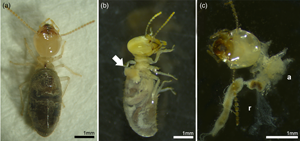Published online by Cambridge University Press: 27 May 2020

Suicidal behavior in termite workers is an extreme defensive strategy, probably a consequence of having a low number of soldiers available in the colony and there being high predation from enemies. We investigated the suicidal mechanism in workers of the Neotropical termite Neocapritermes opacus, which involves salivary gland autothysis followed by body cuticle rupture and the release of a defensive secretion. Autothysis was triggered by a physical stimulus such as a soldier bite that causes the protrusion of the salivary acini, burst reservoirs, and foregut. Histochemical and ultrastructural analyses showed salivary acini composed of peripheral parietal cells and two types of central cells, types I and II. Type I cells are filled with large electron-lucent secretory vesicles, which reacted positively to bromophenol blue and xylidine-Ponceau tests, indicating the occurrence of proteins. Type II cells are elongated and display smaller apical secretory vesicles. Parietal cells present an intracellular canaliculus with dense microvilli and cytoplasm rich in mitochondria and large electron-dense vesicles, which may participate in the self-destructive mechanism. Worker suicidal behavior was previously reported for N. taracua and N. braziliensis. N. opacus is a new species in which a salivary weapon has been developed and factors contributing to this altruistic response are discussed.